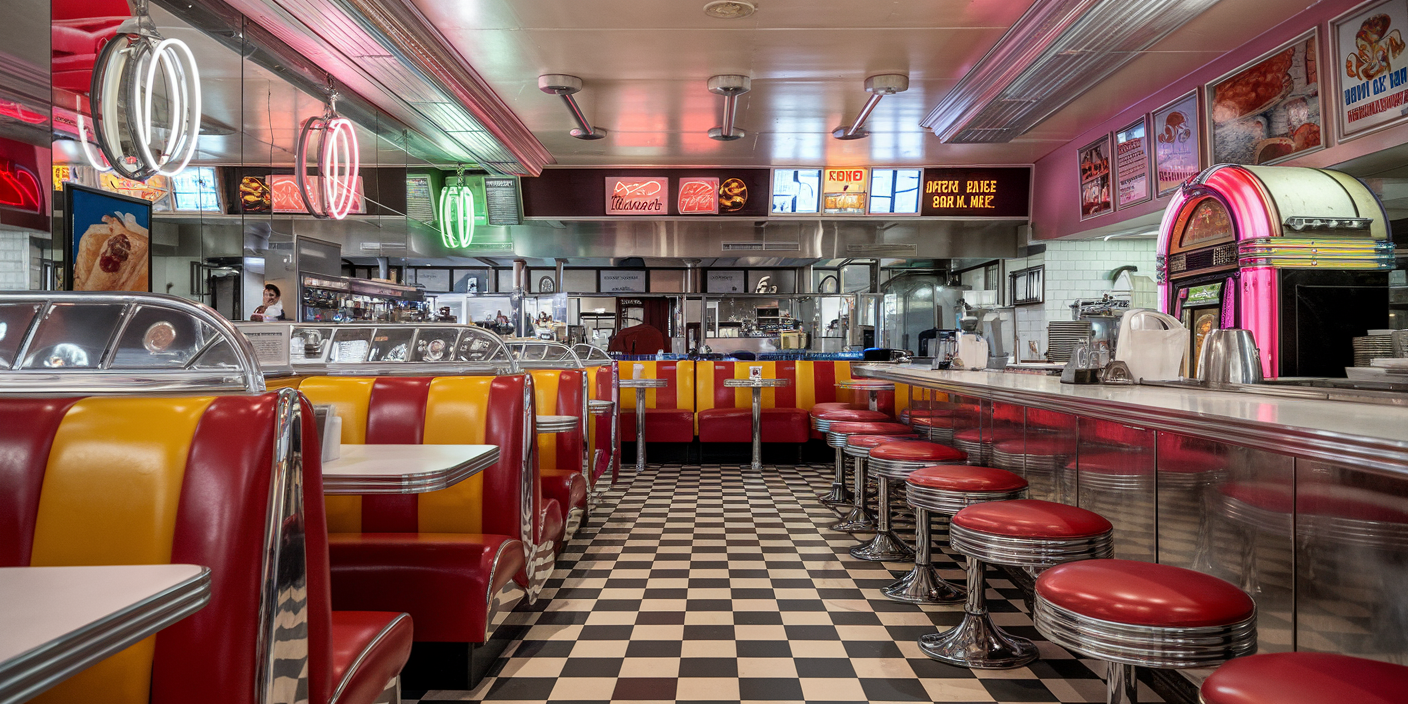Creating a vintage American restaurant interior transports diners to a bygone era while delivering contemporary comfort and service. This nostalgic design aesthetic celebrates America’s rich culinary history through thoughtful décor, authentic materials, and atmospheric details. Whether you’re planning a new restaurant concept or refreshing an existing space, here’s how to capture the essence of vintage American dining.




Classic Era Inspirations
Vintage American restaurant design draws from several distinctive periods:
- 1920s-30s Art Deco: Geometric patterns, rich colors, and glamorous metallic accents
- 1940s-50s Diners: Chrome fixtures, vinyl booths, checkerboard floors, and neon signage
- 1950s-60s Mid-Century: Clean lines, organic shapes, and optimistic space-age influences
- 1970s Supper Clubs: Warm wood paneling, textured fabrics, and intimate lighting
Each era offers unique design elements that can be incorporated authentically or reinterpreted for contemporary appeal.
Signature Flooring Options
The foundation of vintage American restaurant design often begins with iconic flooring:
- Black and white checkerboard tile for classic diner aesthetics
- Hexagonal penny tile with dark grout for early 20th-century charm
- Terrazzo for mid-century sophistication
- Hardwood planks for warmth and timeless appeal
These distinctive flooring choices immediately establish period authenticity while providing durability for high-traffic commercial environments.
Vintage Seating Arrangements
Seating defines the dining experience and creates instant nostalgia:
- High-backed leather booths with button tufting
- Chrome-framed chairs with vinyl upholstery in vibrant colors
- Swiveling counter stools with round seats
- Curved banquettes creating intimate dining nooks
- Windsor or bentwood chairs for farmhouse-inspired spaces
The right combination of seating options creates visual interest while accommodating different dining preferences.
Authentic Wall Treatments
Wall finishes contribute significantly to vintage atmosphere:
- Beadboard or wainscoting painted in heritage colors
- Textured wallpaper in period-appropriate patterns
- Exposed brick for industrial or urban aesthetics
- Wood paneling for mid-century warmth
- Painted murals depicting local historical scenes
Consider incorporating a signature wall that becomes an Instagram-worthy backdrop for diners.
Nostalgic Lighting Elements
Lighting fixtures offer powerful period references:
- Milk glass pendants for 1930s-40s charm
- Chrome and colorful enamel fixtures for diner authenticity
- Sputnik chandeliers for mid-century modern spaces
- Schoolhouse globes for timeless Americana
- Neon signs and illuminated menu boards
Layer lighting to create both ambiance and functionality while showcasing vintage fixtures as decorative elements.
Countertops and Bar Surfaces
The materials used for service areas reinforce the vintage aesthetic:
- Formica laminate with boomerang or atomic patterns
- Polished stainless steel with rounded edges
- Soda fountain-style white marble
- Rich mahogany or walnut for upscale establishments
- Zinc or copper with natural patina
These surfaces should balance period authenticity with durability for commercial use.
Memorabilia and Americana
Thoughtfully curated décor items bring the vintage concept to life:
- Antique advertising signs and product packaging
- Historical photographs of local landmarks
- Vintage kitchen implements and culinary tools
- Classic American brand ephemera
- Jukeboxes, pinball machines, or arcade games for interactive nostalgia
Avoid overcrowding with objects—curate displays that tell a cohesive story.
Regional American Influences
Consider incorporating regional American design traditions:
- New England shipyard and maritime influences
- Southern plantation and porch aesthetics
- Western ranch and saloon elements
- California roadside diner culture
- Chicago speakeasy sophistication
Regional specificity creates a more authentic and distinctive dining experience.
Modern Functionality Within Vintage Design
Balance nostalgia with contemporary needs:
- Comfortable seating with proper ergonomics
- Acoustic treatments disguised as vintage elements
- Energy-efficient lighting with period-appropriate fixtures
- ADA-compliant layout and facilities
- Subtle technology integration for modern operations
The most successful vintage restaurants honor the past while acknowledging present-day requirements.
Conclusion
A well-executed vintage American restaurant interior creates an immersive experience that resonates with diners of all ages. By authentically incorporating design elements from America’s rich culinary past, you can create a dining environment that feels both nostalgic and fresh—a place where guests connect with shared cultural memory while enjoying contemporary cuisine and service.
The key to success lies in thoughtful curation rather than simple replication—creating spaces that honor the past while remaining relevant and comfortable for today’s diners. When done right, vintage American restaurant design creates an atmosphere of familiar comfort that encourages lingering, conversation, and return visits.


Leave a Reply